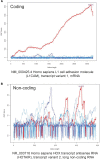CNIT: a fast and accurate web tool for identifying protein-coding and long non-coding transcripts based on intrinsic sequence composition
- PMID: 31147700
- PMCID: PMC6602462
- DOI: 10.1093/nar/gkz400
CNIT: a fast and accurate web tool for identifying protein-coding and long non-coding transcripts based on intrinsic sequence composition
Abstract
As more and more high-throughput data has been produced by next-generation sequencing, it is still a challenge to classify RNA transcripts into protein-coding or non-coding, especially for poorly annotated species. We upgraded our original coding potential calculator, CNCI (Coding-Non-Coding Index), to CNIT (Coding-Non-Coding Identifying Tool), which provides faster and more accurate evaluation of the coding ability of RNA transcripts. CNIT runs ∼200 times faster than CNCI and exhibits more accuracy compared with CNCI (0.98 versus 0.94 for human, 0.95 versus 0.93 for mouse, 0.93 versus 0.92 for zebrafish, 0.93 versus 0.92 for fruit fly, 0.92 versus 0.88 for worm, and 0.98 versus 0.85 for Arabidopsis transcripts). Moreover, the AUC values of 11 animal species and 27 plant species showed that CNIT was capable of obtaining relatively accurate identification results for almost all eukaryotic transcripts. In addition, a mobile-friendly web server is now freely available at http://cnit.noncode.org/CNIT.
© The Author(s) 2019. Published by Oxford University Press on behalf of Nucleic Acids Research.
Figures




References
-
- Eddy S.R. Non-coding RNA genes and the modern RNA world. Nat. Rev. Genet. 2001; 2:919–929. - PubMed
-
- Wan Q., Guan X., Yang N., Wu H., Pan M., Liu B., Fang L., Yang S., Hu Y., Ye W. et al. .. Small interfering RNAs from bidirectional transcripts of GhMML3_A12 regulate cotton fiber development. New Phytol. 2016; 210:1298–1310. - PubMed
Publication types
MeSH terms
Substances
LinkOut - more resources
Full Text Sources
Research Materials

